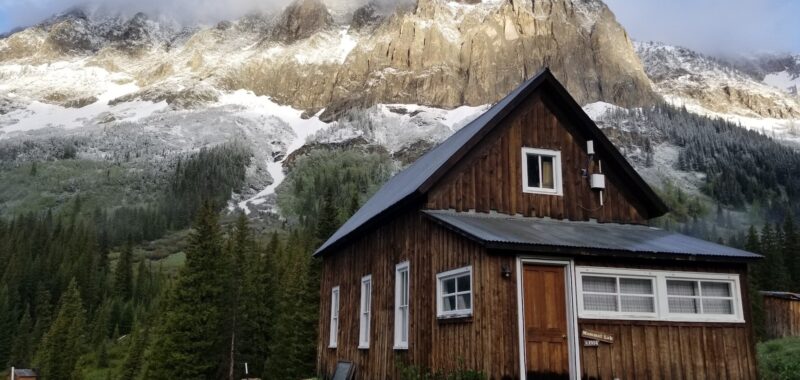North of Crested Butte, Colorado sits Gothic, an abandoned silver mining town established in the 1870s. The unincorporated town is the only outpost of civilization in the valleys and mountains between Crested Butte and Aspen. When silver ran thin and miners deserted the area, the biologically diverse valley turned out to be rich in far more than minerals. Now, Gothic is home to one of the most prolific environmental research stations in the world: the Rocky Mountain Biological Laboratory (RMBL).
Since it was established in 1928, more than 9,000 scientists, students, and staff have worked, lived, and studied at RMBL. At least 200 researchers call the valley home each summer, and more than two thousand papers have been published on everything from marmots to pollinators to biodiversity.


Images: Dave Basden
It’s one of the most diverse alpine regions in the world, covering multiple ecological biozones within a relatively small geographic area. It’s an ideal location for studying pollination networks due to its wildflower diversity, plus it’s home to the second longest—but the longest continuous—living mammal study in the world, surpassed only by Jane Goodall’s research with chimps. The mammal in question in Colorado, however, is marmots.
Studies on behavior patterns of this important indicator species started in 1962 and because they’re such highly studied creatures, their behavior can be used to track changes in the environment. For example, explains John Hausdoerffer, director of scientific communications at RMBL, marmots that continuously emerge earlier in the spring and migrate higher up the mountain provide evidence of rising overall temperatures.
Plus, “Biological processes are the same everywhere, so what we’re learning can be applied to other species in other places,” says Ericka Bremer, development manager at RMBL.
But there’s more being studied than large rodents at this idyllic station spread across a 30-by-30 square kilometer area in the mountains. In fact, the bulk of research happening in Gothic is to help build and shape historical environmental databases and provide data to inform decisions around conservation. Research that is important within specific ecological and environmental sciences and more broadly for global sustainability, explains Jeni Blacklock, RMBL executive director.

For example, billy barr [sic]—the unofficial mayor of Gothic who’s lived full-time at RMBL since 1972—has been recording snowpack, snow melt, and daily temperatures for over 50 years. In the last few years, researchers have also incorporated radiation measurements, humidity, and wind speed, all of which help tell a more detailed story about what’s happening in the environment year over year. In fact, the long-term data collected may be the most important work RMBL undertakes.
Drones cruise overhead to study patterns in the landscape. Long term water ecology and hydrology studies collect info on flow rate and water-based species. A long-term study of wildflowers and temperature data highlights, among other things, how sagebrush competes with wildflowers. The goal is to track as many data points as possible and log it all in order to understand the depth and breadth of the complete ecosystem from atmosphere to animals to water and what they have to do with one another and a changing climate.
These layered insights allow researchers to analyze and better understand how water cycles, weather patterns, and atmospheric changes influence entire ecosystems, including predicting water availability. Blacklock explains, “By linking temperature records, CO₂ levels and precipitation data with ecological observations, researchers can assess how rising global temperatures are impacting plant growth, pollination cycles and carbon storage.”

This data helps inform policymakers, conservationists and industries so they can make more science-based decisions about land use, water management and climate resilience to help preserve biodiversity and adapt to environmental changes. In fact, RMBL research has helped shape the Clean Air Act, Clean Water Act, and global assessments on pollination and global food supply.
The non-profit, non-partisan organization partners with a slew of individuals and organizations including the Nature Conservancy and the National Forest Service—and relies on plenty of grants from the National Science Foundation and NASA—to study the surrounding environment. Then RMBL makes most of their data public because “Data is powerful,” Bremer emphasized. And the station has plenty of it.
“It’s a destination for long-term thinking in a short-term society,” Hausdoerffer says. “We have this incredible long-term capacity that’s important and rare.”
“These long-term records provide an unparalleled window into how ecosystems evolve over time,” Blacklock adds. “Without this type of long-term monitoring, it would be impossible to accurately assess trends in biodiversity, ecosystem resilience, and environmental shifts.”
She continues, “Cross-disciplinary research can provide real-world solutions to the pressing environmental challenges of the 21st century. By continuing to collect, analyze, and integrate these long-term data sets, RMBL is at the forefront of shaping a more informed future for society.”
For those who want to see science in action, visitors can check out RMBL year-round, though only a handful of people staff the station once snow starts to fall and no buildings are open save for two huts available to rent for backcountry trips. Winter visits also require skis, snowshoes, or a fat bike as the 3.5-mile road is closed to motorized vehicles. But in the summer the road is drivable and the visitor center is open to all so curious travelers can witness scientists hard at work as they enjoy the beauty of the valley.



